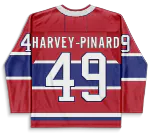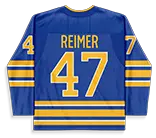
NHL Hockey Player News


Nikolaev was the third-round pick, 88th overall, of the Calgary Flames in the 2019 NHL Entry Draft. The 23-year-old has never played an NHL game and scored four points (0G / 4A) in nine games with the Calgary Wranglers (AHL) this season.
Kapanen struggled to establish himself with the Blues, in and out of the lineup this season, being limited to only one point (1G / 0A) in 10 games, resulting in him being placed on waivers. He has 23 points (7G / 16A) in 83 total games with the Blues over the previous two seasons.

Kapanen has struggled to establish himself with the Blues, in and out of the lineup this season, being limited to only one point (1G / 0A) in 10 games while averaging 11:19 time-on-ice through 10 games. He has 23 points (7G / 16A) in 83 total games with the Blues over the previous two seasons.

Reimer was signed by the Anaheim Ducks in the offseason and played two games with them (0-2-0), recording a 4.50 GAA and .864 SV%. The veteran Reimer provides some goaltending depth for a Sabres club that is temporarily without starting goalie Ukko-Pekka Luukkonen (undisclosed).

Kahkonen was placed on waivers by the Jets earlier this season and claimed by the Avalanche. The 28-year-old Kahkonen had one game to prove himself in an Avalanche uniform but allowed four goals on 20 shots (.800 SV%) in a losing effort and was placed back on waivers, reclaimed by the Jets. Kahkonen had a poor 2023-24 campaign split between the San Jose Sharks and New Jersey Devils, posting a 3.64 GAA and .898 SV%.

Benning was acquired in a trade earlier this season that sent Timothy Liljegren to the San Jose Sharks. The 30-year-old Benning has not played a single game with the Maple Leafs since the trade and had zero points, 10 blocks, and nine hits in seven games with the Sharks.

Athanasiou, a one-time 30-goal scorer, has been placed on waivers by the Blackhawks. The 30-year-old Athanasiou scored 30 goals in 76 games in the 2018-19 season but has only scored 54 in 244 games since. He has zero points in five games this season.

Fabbro has spent the first seven seasons of his career with the Nashville Predators, the team that drafted him 17th overall in the 2016 NHL Entry Draft. The 26-year-old Fabbro was in and out of the lineup with the Predators this season, recording zero points and a -3 plus/minus in six games.


Svejkovsky was a fourth-round pick of the Penguins in the 2020 NHL Entry Draft. The 22-year-old has never played an NHL game and has 20 points (6G / 14A) in 70 career AHL games between the Wilkes-Barre/Scranton Penguins and the Syracuse Crunch.

Novak was a fifth-round pick of the Minnesota Wild in the 2020 NHL Entry Draft. The 22-year-old made his North American professional hockey debut last season, splitting time between the Iowa Heartlanders (ECHL) and the Iowa Wild (AHL).
Ryan has not played an NHL game since the 2020-21 NHL season and will likely debut in the AHL this season after being placed on waivers for the purpose of being reassigned to the Chicago Wolves (AHL). The 31-year-old Ryan has 24 points (4G / 20A) in 145 career NHL games.

Three days after allowing four goals on 14 shots (.714 SV%) in the Red Wings' season opener, Ville Husso has been placed on waivers. The 29-year-old carries a $4.75 million cap hit this season and is expected to be sent to Grand Rapids if unclaimed on Monday.

The Avalanche have added some depth to their goaltending position behind Alexandar Georgiev and Justus Annunen by claiming Kahkonen from the Winnipeg Jets. Kahkonen had a poor 2023-24 campaign split between the San Jose Sharks and New Jersey Devils, posting a 3.64 GAA and .898 SV%, but could get an opportunity at the crease in Colorado if Georgiev and Annunen are unable to provide consistent efforts.

Lavoie has had a whirlwind start to his 2024-25 campaign. Lavoie was signed to a one-year, two-way contract extension by the Edmonton Oilers in the offseason, placed on waivers last week, claimed by the Vegas Golden Knights, re-claimed by the Oilers, and ultimately claimed again by the Golden Knights. The 24-year-old was Edmonton's 2019 2nd-round pick (38th overall) and has appeared in seven games with the Oilers since making his debut last season. In 66 games with Bakersfield (AHL) in 2023-24, he had 28 goals, 50 points and 64 PIMs in 66 games played.

Lavoie was signed to a one-year, two-way contract extension in the offseason, placed on waivers last week, claimed by the Vegas Golden Knights, and ultimately re-claimed by the Oilers. The 24-year-old was Edmonton's 2019 2nd-round pick (38th overall) and has appeared in seven games with the Oilers since making his debut last season. In 66 games with Bakersfield (AHL) in 2023-24, he had 28 goals, 50 points and 64 PIMs in 66 games played.

Aston-Reese signed a one-year, two-way contract with Vegas in the offseason but has been claimed off waivers by Columbus on Monday. The 29-year-old carries a $775,000 cap hit into the 2024-25 season and should provide much-needed depth for the Blue Jackets offence. In three games with Detroit in 2023-24, he failed to pick up a point while averaging only 5:09 TOI/GP.

Vegas made another waiver claim on Monday as they scooped up right-winger Raphael Lavoie from Edmonton. The 24-year-old was Edmonton's 2019 2nd-round pick (38th overall) and has appeared in seven games with the Oilers since making his debut last season. In 66 games with Bakersfield (AHL) in 2023-24, he had 28 goals, 50 points and 64 PIMs in 66 games played.
